标签:指定 优点 keep cells 编辑 row add 基本用法 user
一、理论部分
1、接口
用interface声明,是抽象方法和常量值定义的集 合。从本质上讲,接口是一种特殊的抽象类。
在Java程序设计语言中,接口不是类,而是对类 的一组需求描述,由常量和一组抽象方法组成。接口中不包括变量和实现的方法。接口体中包含常量定义和方法定义,接口中只进 行方法的声明,不提供方法的实现。通常接口的名字以able或ible结尾;接口中的所有常量必须是public static final,方法必须是public abstract,这是 系统默认的,不管你在定义接时,写不写 修饰符都是一样的.接口的实现:一个类使用了某个接口,那么这个类必须实现该 接口的所有方法,即为这些方法提供方法体。一个类可以实现多个接口,接口间应该用逗号分 隔开。接口的使用:接口不能构造接口对象,但可以声明接口变量以指向一个实现了该接口的类对象。可以用instanceof检查对象是否实现了某个接口。
抽象类:用abstract来声明,没有具体实例对象的类,不 能用new来创建对象。
2、 接口示例
(回调(callback):一种程序设计模式,在这种模 式中,可指出某个特定事件发生时程序应该采取 的动作。Comparator接口所在包: java.util.*Object类的Clone方法:当拷贝一个对象变量时,原始变量与拷贝变量 引用同一个对象。这样,改变一个
变量所引用 的对象会对另一个变量产生影响。如果要创建一个对象新的copy,它的最初状态与 original一样,但以后可以各自改变状态,就需 要使用Object类的clone方法。Object.clone()方法返回一个Object对象。必须进行强 制类型转换才能得到需要的类型。
3、浅层拷贝与深层拷贝
(1)Java中对象克隆的实现:在子类中实现Cloneable接口。
(2)在子类的clone方法中,调用super.clone()。
4、lambda表达式
(1)Java Lambda 表达式是 Java 8 引入的一个新的功能,主 要用途是提供一个函数化的语法来简化编码。
(2)Lambda 表达式的语法基本结构 (arguments) -> body
(3)有如下几种情况:
a.参数类型可推导时,不需要指定类型,如 (a) -> System.out.println(a)
b. 只有一个参数且类型可推导时,不强制写 (), 如 a -> System.out.println(a)
c. 参数指定类型时,必须有括号,如 (int a) -> System.out.println(a)
d.参数可以为空,如 () -> System.out.println(“hello”)
e. body 需要用 {} 包含语句,当只有一条语句时 {} 可省略
5、 内部类:是定义在一个类内部的类。
使用内部类的原因有以下三个:
–内部类方法可以访问该类定义所在的作用域中 的数据,包括私有数据。内部类能够隐藏起来,不为同一包中的其他类 所见。
–想要定义一个回调函数且不想编写大量代码时, 使用匿名内部类比较便捷。
内部类可以直接访问外部类的成员,包括 private成员,但是内部类的成员却不能被外部 类直接访问。内部类并非只能在类内定义,也可以在程序块内 定义局部内部类。如果构造参数的闭圆括号跟一个开花括号,表明正 在定义的就是匿名内部类。
二、目的与要求
(1) 掌握接口定义方法;
(2) 掌握实现接口类的定义要求;
(3) 掌握实现了接口类的使用要求;
(4) 掌握程序回调设计模式;
(5) 掌握Comparator接口1、实验用法;
(6) 掌握对象浅层拷贝与深层拷贝方法;
(7) 掌握Lambda表达式语法;
(8) 了解内部类的用途及语法要求。
2、实验内容和步骤
实验1: 导入第6章示例程序,测试程序并进行代码注释。
测试程序1:
l 编辑、编译、调试运行阅读教材214页-215页程序6-1、6-2,理解程序并分析程序运行结果;
l 在程序中相关代码处添加新知识的注释。
l 掌握接口的实现用法;
l 掌握内置接口Compareable的用法。
package interfaces; import java.util.*; /** * This program demonstrates the use of the Comparable interface. * @version 1.30 2004-02-27 * @author Cay Horstmann */ public class EmployeeSortTest { public static void main(String[] args) { Employee[] staff = new Employee[3]; staff[0] = new Employee("Harry Hacker", 35000); staff[1] = new Employee("Carl Cracker", 75000); staff[2] = new Employee("Tony Tester", 38000); Arrays.sort(staff); // 打印所有员工对象的信息 for (Employee e : staff) System.out.println("name=" + e.getName() + ",salary=" + e.getSalary()); } }
package interfaces; public class Employee implements Comparable<Employee> { private String name; private double salary; public Employee(String name, double salary) { this.name = name; this.salary = salary; } public String getName() { return name;//name访问器 } public double getSalary() { return salary; //salary访问器 } public void raiseSalary(double byPercent) { double raise = salary * byPercent / 100; salary += raise; } /** * Compares employees by salary * @param other another Employee object * @return a negative value if this employee has a lower salary than * otherObject, 0 if the salaries are the same, a positive value otherwise */ public int compareTo(Employee other) { return Double.compare(salary, other.salary); } }
实验结果如下图所示:
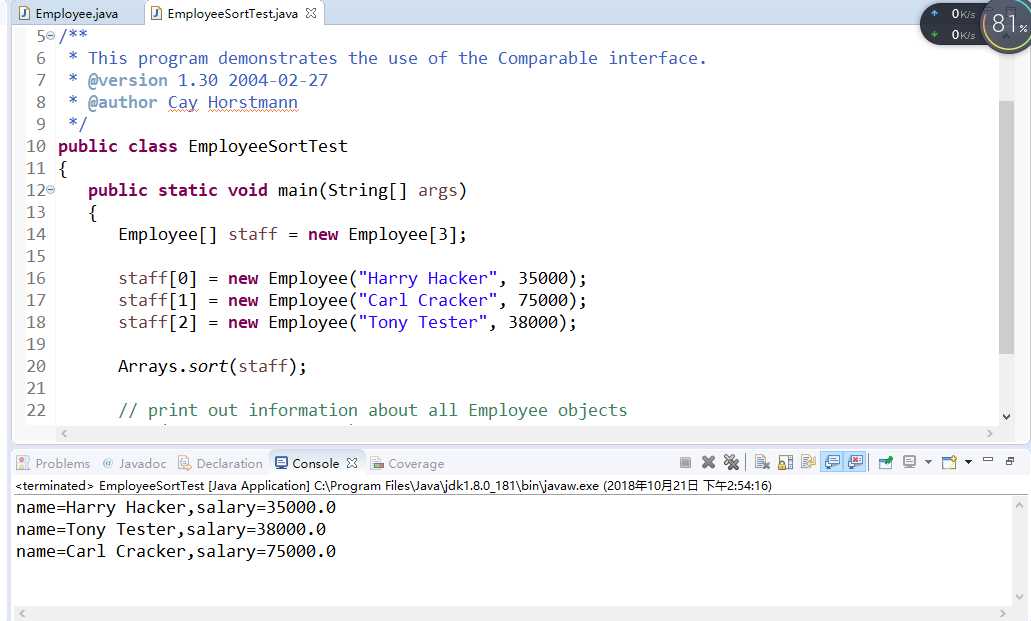
测试程序2:
l 编辑、编译、调试以下程序,结合程序运行结果理解程序;
|
interface A { double g=9.8; void show( ); } class C implements A { public void show( ) {System.out.println("g="+g);} }
class InterfaceTest { public static void main(String[ ] args) { A a=new C( ); a.show( ); System.out.println("g="+C.g); } } |
实验结果如下图所示:
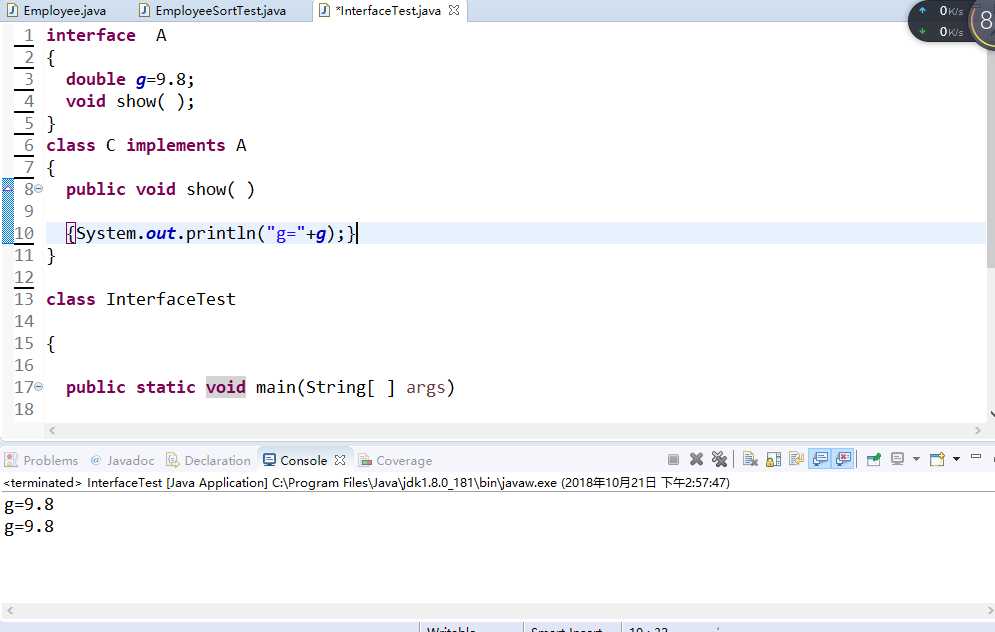
测试程序3:
l 在elipse IDE中调试运行教材223页6-3,结合程序运行结果理解程序;
l 26行、36行代码参阅224页,详细内容涉及教材12章。
l 在程序中相关代码处添加新知识的注释。
l 掌握回调程序设计模式;
/** @version 1.01 2015-05-12 @author Cay Horstmann */ import java.awt.*; import java.awt.event.*; import java.util.*; import javax.swing.*; import javax.swing.Timer; // 解决与java.util.Timer的冲突 public class TimerTest { public static void main(String[] args) { ActionListener listener = new TimePrinter(); //建立一个Timer称作listener // 间隔十秒 Timer t = new Timer(10000, listener); t.start(); //按Quit program则程序停止 JOptionPane.showMessageDialog(null, "Quit program?"); System.exit(0); } } //内置接口 class TimePrinter implements ActionListener { public void actionPerformed(ActionEvent event) { System.out.println("At the tone, the time is " + new Date()); Toolkit.getDefaultToolkit().beep(); } }
实验结果如下图所示:
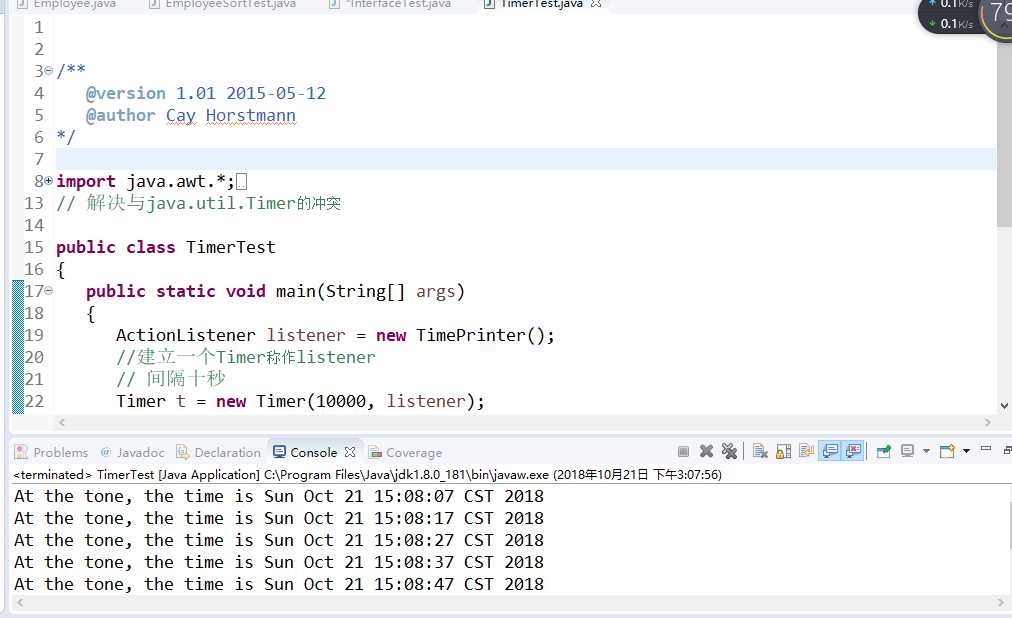
测试程序4:
l 调试运行教材229页-231页程序6-4、6-5,结合程序运行结果理解程序;
l 在程序中相关代码处添加新知识的注释。
l 掌握对象克隆实现技术;
l 掌握浅拷贝和深拷贝的差别。
package clone; /** * This program demonstrates cloning. * @version 1.10 2002-07-01 * @author Cay Horstmann */ public class CloneTest { public static void main(String[] args) { try { Employee original = new Employee("John Q. Public", 50000); original.setHireDay(2000, 1, 1); Employee copy = original.clone(); copy.raiseSalary(10);//原有对象不会发生变化 copy.setHireDay(2002, 12, 31);//构造器 System.out.println("original=" + original); System.out.println("copy=" + copy); } catch (CloneNotSupportedException e) { e.printStackTrace(); } } }
package clone; import java.util.Date; import java.util.GregorianCalendar; public class Employee implements Cloneable { private String name; private double salary; private Date hireDay; public Employee(String name, double salary) { this.name = name; this.salary = salary; hireDay = new Date(); } public Employee clone() throws CloneNotSupportedException { // 创建clone类对象 Employee cloned = (Employee) super.clone(); // 克隆可变字段 cloned.hireDay = (Date) hireDay.clone(); return cloned; } /** * Set the hire day to a given date. * @param year the year of the hire day * @param month the month of the hire day * @param day the day of the hire day */ public void setHireDay(int year, int month, int day) { Date newHireDay = new GregorianCalendar(year, month - 1, day).getTime(); // 实例字段突变的例子 hireDay.setTime(newHireDay.getTime()); } public void raiseSalary(double byPercent) { double raise = salary * byPercent / 100; salary += raise; } public String toString() { return "Employee[name=" + name + ",salary=" + salary + ",hireDay=" + hireDay + "]"; } }
实验结果如下图所示:
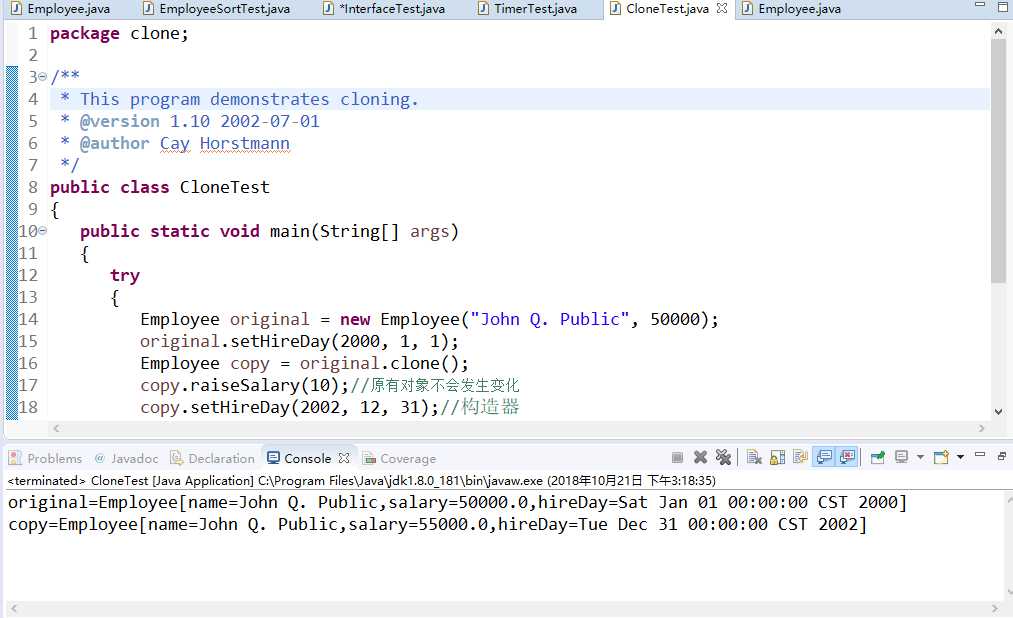
实验2: 导入第6章示例程序6-6,学习Lambda表达式用法。
l 调试运行教材233页-234页程序6-6,结合程序运行结果理解程序;
l 在程序中相关代码处添加新知识的注释。
l 将27-29行代码与教材223页程序对比,将27-29行代码与此程序对比,体会Lambda表达式的优点。
package lambda; import java.util.*; import javax.swing.*; import javax.swing.Timer; /** * This program demonstrates the use of lambda expressions. * @version 1.0 2015-05-12 * @author Cay Horstmann */ public class LambdaTest { public static void main(String[] args) { String[] planets = new String[] { "Mercury", "Venus", "Earth", "Mars", "Jupiter", "Saturn", "Uranus", "Neptune" }; System.out.println(Arrays.toString(planets)); System.out.println("Sorted in dictionary order:"); Arrays.sort(planets); System.out.println(Arrays.toString(planets)); System.out.println("Sorted by length:"); Arrays.sort(planets, (first, second) -> first.length() - second.length()); System.out.println(Arrays.toString(planets));//先指定类型再定义表达式 Timer t = new Timer(1000, event -> System.out.println("The time is " + new Date())); t.start(); // 保持程序运行直到用户选择“OK” JOptionPane.showMessageDialog(null, "Quit program?"); System.exit(0); } }
实验结果如下图所示:
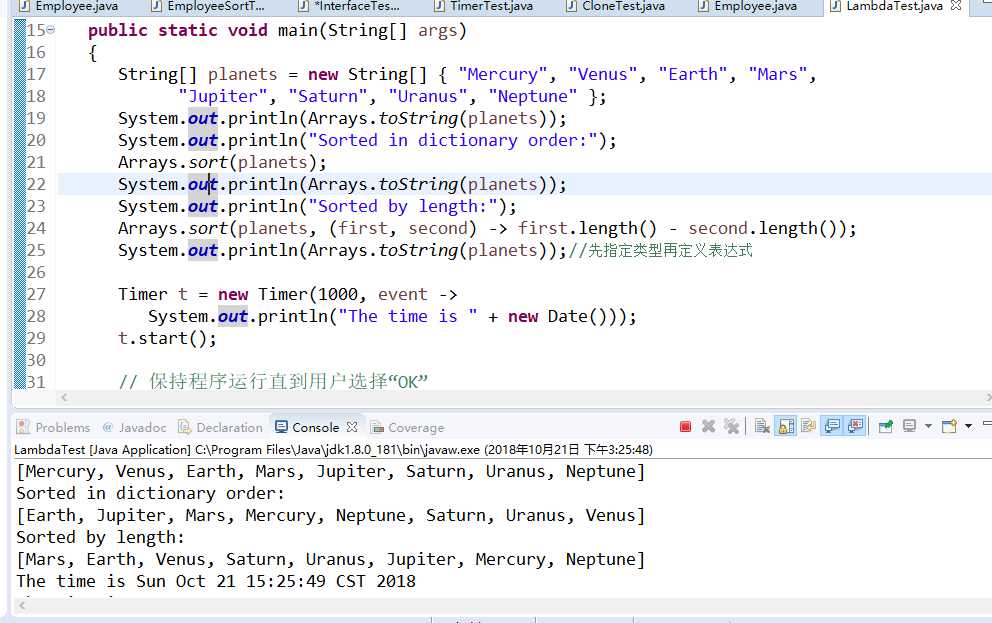
注:以下实验课后完成
实验3: 编程练习
l 编制一个程序,将身份证号.txt 中的信息读入到内存中;
l 按姓名字典序输出人员信息;
l 查询最大年龄的人员信息;
l 查询最小年龄人员信息;
l 输入你的年龄,查询身份证号.txt中年龄与你最近人的姓名、身份证号、年龄、性别和出生地;
l 查询人员中是否有你的同乡。
import java.io.BufferedReader; import java.io.File; import java.io.FileInputStream; import java.io.FileNotFoundException; import java.io.IOException; import java.io.InputStreamReader; import java.util.ArrayList; import java.util.Arrays; import java.util.Collections; import java.util.Scanner; public class M{ private static ArrayList<Test> studentlist; public static void main(String[] args) { studentlist = new ArrayList<>(); Scanner scanner = new Scanner(System.in); File file = new File("D:\\身份证号.txt"); try { FileInputStream fis = new FileInputStream(file); BufferedReader in = new BufferedReader(new InputStreamReader(fis)); String temp = null; while ((temp = in.readLine()) != null) { Scanner linescanner = new Scanner(temp); linescanner.useDelimiter(" "); String name = linescanner.next(); String number = linescanner.next(); String sex = linescanner.next(); String age = linescanner.next(); String province =linescanner.nextLine(); Test student = new Test(); student.setName(name); student.setnumber(number); student.setsex(sex); int a = Integer.parseInt(age); student.setage(a); student.setprovince(province); studentlist.add(student); } } catch (FileNotFoundException e) { System.out.println("学生信息文件找不到"); e.printStackTrace(); } catch (IOException e) { System.out.println("学生信息文件读取错误"); e.printStackTrace(); } boolean isTrue = true; while (isTrue) { System.out.println("1:字典排序"); System.out.println("2:输出年龄最大和年龄最小的人"); System.out.println("3:寻找老乡"); System.out.println("4:寻找年龄相近的人"); System.out.println("5:退出"); String m = scanner.next(); switch (m) { case "1": Collections.sort(studentlist); System.out.println(studentlist.toString()); break; case "2": int max=0,min=100; int j,k1 = 0,k2=0; for(int i=1;i<studentlist.size();i++) { j=studentlist.get(i).getage(); if(j>max) { max=j; k1=i; } if(j<min) { min=j; k2=i; } } System.out.println("年龄最大:"+studentlist.get(k1)); System.out.println("年龄最小:"+studentlist.get(k2)); break; case "3": System.out.println("province?"); String find = scanner.next(); String place=find.substring(0,3); for (int i = 0; i <studentlist.size(); i++) { if(studentlist.get(i).getprovince().substring(1,4).equals(place)) System.out.println("province"+studentlist.get(i)); } break; case "4": System.out.println("年龄:"); int yourage = scanner.nextInt(); int near=agematched(yourage); int value=yourage-studentlist.get(near).getage(); System.out.println(""+studentlist.get(near)); break; case "5": isTrue = false; System.out.println("退出程序!"); break; default: System.out.println("输入有误"); } } } public static int agematched(int age) { int j=0,min=53,value=0,k=0; for (int i = 0; i < studentlist.size(); i++) { value=studentlist.get(i).getage()-age; if(value<0) value=-value; if (value<min) { min=value; k=i; } } return k; } } M
public class Test implements Comparable<Test> { private String name; private String number ; private String sex ; private int age; private String province; public String getName() { return name; } public void setName(String name) { this.name = name; } public String getnumber() { return number; } public void setnumber(String number) { this.number = number; } public String getsex() { return sex ; } public void setsex(String sex ) { this.sex =sex ; } public int getage() { return age; } public void setage(int age) { this.age= age; } public String getprovince() { return province; } public void setprovince(String province) { this.province=province ; } public int compareTo(Test o) { return this.name.compareTo(o.getName()); } public String toString() { return name+"\t"+sex+"\t"+age+"\t"+number+"\t"+province+"\n"; } } Test
实验结果如下图所示:
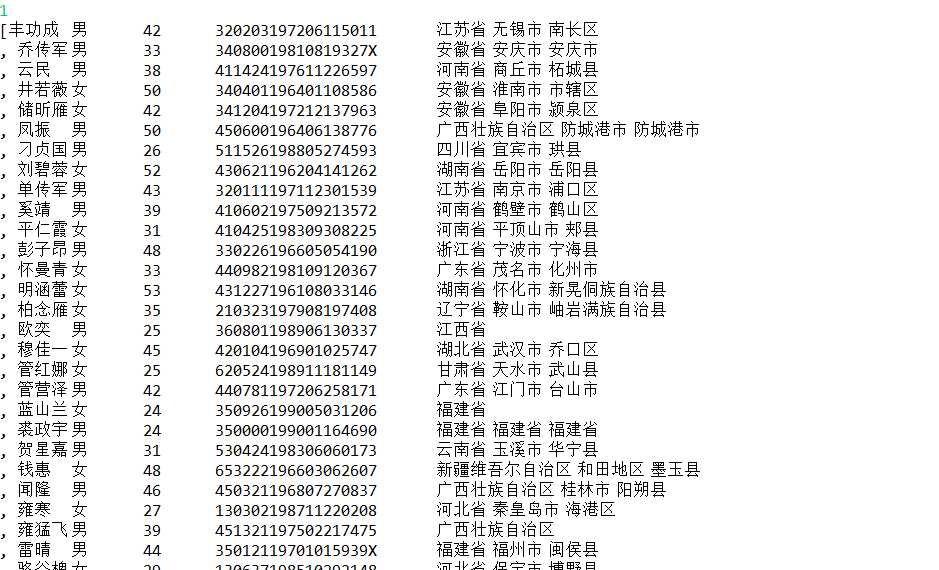



实验4:内部类语法验证实验
实验程序1:
l 编辑、调试运行教材246页-247页程序6-7,结合程序运行结果理解程序;
l 了解内部类的基本用法。
package innerClass; import java.awt.*; import java.awt.event.*; import java.util.*; import javax.swing.*; import javax.swing.Timer; /** * This program demonstrates the use of inner classes. * @version 1.11 2015-05-12 * @author Cay Horstmann */ public class InnerClassTest { public static void main(String[] args) { TalkingClock clock = new TalkingClock(1000, true);//实现了TalkingClock的类对象 clock.start(); // keep program running until user selects "Ok" JOptionPane.showMessageDialog(null, "Quit program?"); System.exit(0);// } } /** * A clock that prints the time in regular intervals. */ class TalkingClock { //声明属性 private int interval; private boolean beep; /** * Constructs a talking clock * @param interval the interval between messages (in milliseconds) * @param beep true if the clock should beep */ public TalkingClock(int interval, boolean beep) { this.interval = interval; this.beep = beep; }//构造方法 /** * Starts the clock. */ public void start() { ActionListener listener = new TimePrinter(); Timer t = new Timer(interval, listener); t.start(); } public class TimePrinter implements ActionListener//实现ActionListener的公共类TimePrinter { public void actionPerformed(ActionEvent event) { System.out.println("At the tone, the time is " + new Date()); if (beep) Toolkit.getDefaultToolkit().beep(); } } }
实验结果如下图所示:

实验程序2:
l 编辑、调试运行教材254页程序6-8,结合程序运行结果理解程序;
l 了解匿名内部类的用法。
package anonymousInnerClass; import java.awt.*; import java.awt.event.*; import java.util.*; import javax.swing.*; import javax.swing.Timer; /** * This program demonstrates anonymous inner classes. * @version 1.11 2015-05-12 * @author Cay Horstmann */ public class AnonymousInnerClassTest { public static void main(String[] args) { TalkingClock clock = new TalkingClock();//TalkingClock类声明为私有的 clock.start(1000, true); // keep program running until user selects "Ok" JOptionPane.showMessageDialog(null, "Quit program?"); System.exit(0); } } /** * A clock that prints the time in regular intervals. */ class TalkingClock { /** * Starts the clock. * @param interval the interval between messages (in milliseconds) * @param beep true if the clock should beep */ public void start(int interval, boolean beep) { ActionListener listener = new ActionListener() { public void actionPerformed(ActionEvent event) { System.out.println("At the tone, the time is " + new Date()); if (beep) Toolkit.getDefaultToolkit().beep(); //外围类引用. } }; Timer t = new Timer(interval, listener); t.start(); } }
实验结果如下图所示:

实验程序3:
l 在elipse IDE中调试运行教材257页-258页程序6-9,结合程序运行结果理解程序;
l 了解静态内部类的用法。
package staticInnerClass; /** * This program demonstrates the use of static inner classes. * @version 1.02 2015-05-12 * @author Cay Horstmann */ public class StaticInnerClassTest { public static void main(String[] args) { double[] d = new double[20]; for (int i = 0; i < d.length; i++) d[i] = 100 * Math.random();//算法 ArrayAlg.Pair p = ArrayAlg.minmax(d); System.out.println("min = " + p.getFirst()); System.out.println("max = " + p.getSecond()); }//访问器 } class ArrayAlg { /** * A pair of floating-point numbers */ public static class Pair { //声明私有属性 private double first; private double second; /** * Constructs a pair from two floating-point numbers * @param f the first number * @param s the second number */ public Pair(double f, double s) { first = f; second = s; } /** * Returns the first number of the pair * @return the first number */ public double getFirst() { return first; } // 访问器 /** * Returns the second number of the pair * @return the second number */ public double getSecond() { return second; } } /** * Computes both the minimum and the maximum of an array * @param values an array of floating-point numbers * @return a pair whose first element is the minimum and whose second element * is the maximum */ public static Pair minmax(double[] values) { double min = Double.POSITIVE_INFINITY; double max = Double.NEGATIVE_INFINITY;//变量 for (double v : values) { if (min > v) min = v; if (max < v) max = v; } return new Pair(min, max); } }
实验结果如下图所示:

三、实验总结
本章主要学习了掌握接口定义方法;实现接口类的定义要求;实现了接口类的使用要求;程序回调设计模式;Comparator接口用法;对象浅层拷贝与深层拷贝方法;Lambda表达式语法;内部类的用途及语法要求。并知道了object类的clone方法,通过学长在群里的讲解明白了接口和继承之间的区别。
201771010123汪慧和《面向对象程序设计JAVA》第八周实验总结
标签:指定 优点 keep cells 编辑 row add 基本用法 user
原文地址:https://www.cnblogs.com/http-www-whh0601-cnblogs-com/p/9825434.html